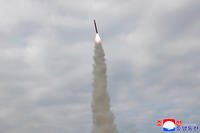U.S. Army scientists are studying how running electrical current through the brain could enhance soldier performance when reacting to a threat on the battlefield.
Neurostimulation has been studied in many areas, such as medical rehabilitation.
"What we are doing is brand new. ... We are looking specifically at performance enhancement," Tad Brunye, senior cognitive scientist for the U.S. Army's Combat Capabilities Development Command, told Military.com on Thursday at a technology demonstration event at the Pentagon.
"We are focused on three primary things when it comes to soldier performance," he said. "We are focused on situational awareness, lethality and decision making."
Related: Super SEALs: Elite Units Pursue Brain-Stimulating Technologies
Many high-tech companies are offering devices that send low-intensity current through electrodes attached to the skull as a way of increasing brain activity, Brunye said.
"What we are doing here is, we are sending in very low currents of electricity into the brain, so we are talking about on the order of nine to 12 volts," he said. "So this is very low intensity. If you went and licked a nine-volt battery like you did when you were a kid, you were getting much more electrical current doing that."
The majority of the electrical current ends up traveling across the scalp and into the fatty tissue and the skull, Brunye said.
"But about 10 percent or so is actually making it into the cortex ... and that 10 percent seems to be enough," he said. "It seems to be sufficient to drive changes."
This can result in the depolarization of neuromembranes -- lowering the thresholds so neuron populations can fire sooner, he said.
"It's not going to make the neurons fire; all it does is it changes the potential for those neurons to fire subsequently when you need those neurons to perform a task," Brunye said.
Army scientists are studying this to see how well it affects what's known as the OODA Loop: observe, orient, decide and act.
"How well are you observing your environment for threats, how quickly do you orient to those threats when they emerge, how confidently and accurately do you make a decision about it and how well in a marksmanship sense do you engage and act upon it?" Brunye said.
The Army is "not very far" from using this type of technology in some training activities, he said.
"The reason I say that is because some of these systems are already being used by soldiers," Brunye said. "They put them on for 15 to 20 minutes. They believe that it's helping them recover better, and they wake up the next morning … feeling invigorated and refreshed and ready for the next day."
Special Operations Command has already started to incorporate some off-the shelf devices into training to try them out and get subjective feedback, Brunye said.
"I predict that in the next five to 10 years, that this will be used in specialized training, and then I would say the next 10 to 20 years is probably ripe for some field applications," he said.
-- Matthew Cox can be reached at matthew.cox@military.com.















